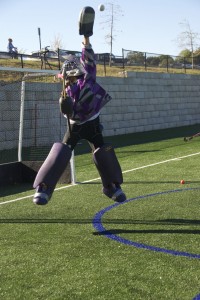Mike Nussbaum ’11
Web Managing Editor

It’s a goalie’s worst nightmare: a penalty shot to decide a crucial second round state championship game. Jenn Hoets ’11 sets up in goal, taps her pads, looks to make sure she is not favoring one side of the net and crouches into her ready position. Hoets looks her opponent in the eye as she makes a dashing move towards the goal. Hoets, like many other goalies, predicts the move her opponent is going to make and reacts accordingly. This time, she happened to be wrong.
This was the dramatic ending to the girls’ field hockey team’s 2008-2009 season. This was the gut wrenching feeling Hoets experienced. This is the feeling to familiar for many goalies: the feeling of giving up a goal.
James Hickok ’13, a goalie for the boys’ soccer team, like many other goalies, often becomes frustrated after letting up a goal.
“It’s a crushing feeling,” said Hickok, “it makes [me] angry because maybe I could have saved [the shot] but maybe I lost my mental edge for a brief moment.”
The life of a goalie brings many challenges, and contrary to popular belief, it is not the physical part of being a goalie that is the most strenuous.
“The hardest part about being a goalie is keeping your head,” said Luke Andriuk ’11, goalie for the boys’ hockey team. “Everyone gives up a goal, but what defines your skill as a goalie is whether you sit back and give up three more goals or if you shutdown the other team for the rest of the game. Its that choice that defines a truly skilled goalie.”
Hickok feels similarly.
“[The hardest part about being] a goalie is knowing that the only way your team can lose the game is if the opponents get the ball by you,” Hickok said.
Even though the life of a goalie brings its challenges, its the thrill of the position–the feeling that you have the power to change the course of the game–that doesn’t scare away many unsuccessful goalies.
Hoets’ first experience behind the net was by chance. She recalls her team needed a goalie, and she “jokingly suited up and did surprisingly well.” Since that day, Hoets has fell in love with being a goalie. Hoets embraced the goalie position.
Andriuk has been playing goalie since seventh grade, and first took the ice as a goalie because the goalie for his team wanted a break. Andriuk volunteered, and got into the net with his pads on backwards. However, he has stuck to it ever since because it is the “most exciting and rewarding position.” Andriuk specifically finds excitement from the focus and the attention that a goalie receives.
Hickok played the position when he was eight, when “[his] friend jokingly raised [his] hand when the coach asked if anyone wanted to be the goalie.” Hickok also recalls that when he was younger, the goalie position was always the one that “everyone hated.” He jokingly recalls his fear at the early stages of his goalie career, when he was afraid of the ball.
These three athletes, from different situations, all stuck with the position. Why? Although it seems that giving up a goal can be disastrous, saving one, brings joy, relief, and everything in between to a goalie.
“There is no better feeling than making a playmaking save,” said Andriuk, “the crowd booms with cheers and teammates tap you and save ‘great save’.”
One save, Andriuk says, can mean the difference between a win and loss. Hoets agrees, adding her take on the unique of saving a goal.
“I feel lighter in a sense that I’ve stopped a goal from happening,” Hoets said. “Once I make a save, I feel a boost of adrenaline and from there I play at a higher level then before.”
Hoets accredits her resiliency in goal, even after letting up a game-winning goal, to the balance with being in goal.
“I stay with [being a goalie] because there are moments where you make an amazing save that can propel you to the next round as well. It’s all a balance.”












































